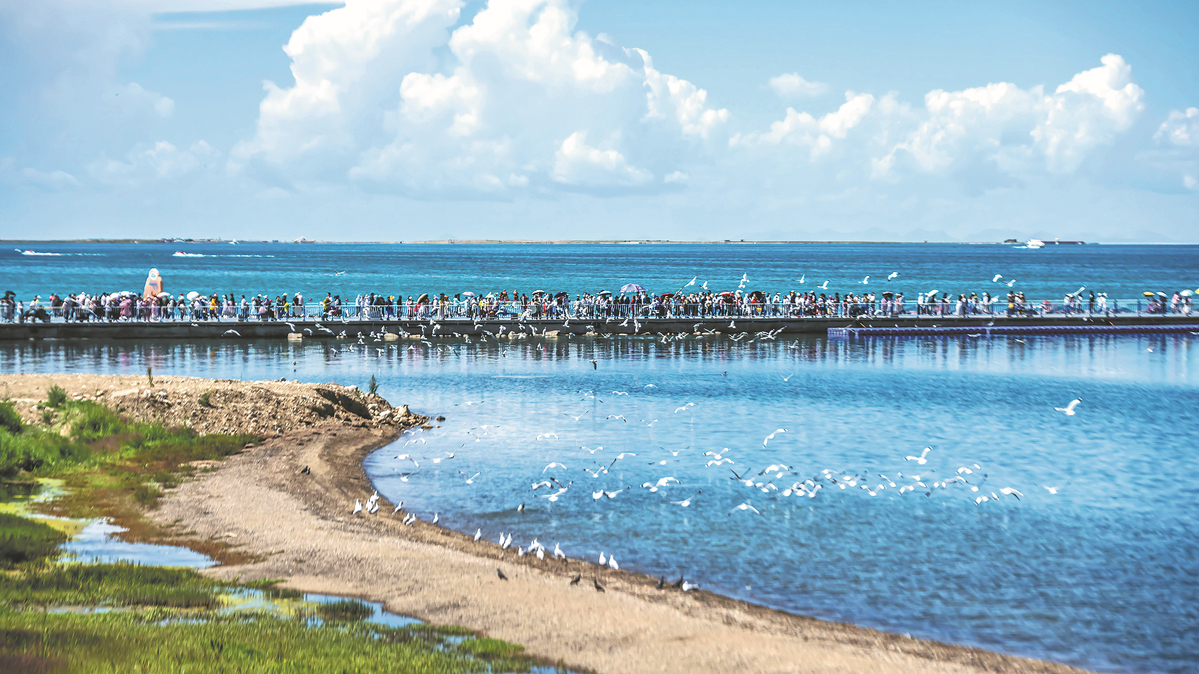Source:Qinghai Lake to become national park 2024-03-19

Tourists pose for pictures at the Erlangjian scenic area of Qinghai Lake in Xining, Qinghai province, in May. ZHANG LONG/XINHUA
XINING — Qinghai Lake, China's largest inland saltwater lake, is poised to become a new national park, a milestone in the environmental protection efforts of the Qinghai-Tibet Plateau.
All tasks required for the establishment of the park have been completed, said Wu Xiaojun, governor of Northwest China's Qinghai province.
Wu added that Qinghai has proved to be a leader in national park construction, citing the release of a master plan for the comprehensive protection of the Sanjiangyuan National Park last year as well as the upcoming official designation of the Qilian Mountain National Park.
Qinghai Lake, located in the northeastern part of the Qinghai-Tibet Plateau, is an important ecological barrier in northern China and a key stopover site for migratory birds.
In 2022, China approved a plan to establish a national park at the lake, which has witnessed improvements in its environment and the rapid restoration of its biodiversity in recent years.
"The planned scope of the Qinghai Lake national park demonstrates its national representativeness, ecological significance and the feasibility of management," said Dong Fuhai, director of the protection and utilization administration in the Qinghai Lake scenic area.
According to the plan, the core protection areas of the park consist of the main source areas of rivers flowing into Qinghai Lake, the habitats of rare and endangered species such as the Przewalski's gazelle, key migratory channels for the naked carp and areas critical for bird migration.
Based on the pivotal status of Qinghai Lake in terms of ecological security, the local government has adopted a holistic strategy to safeguard the authenticity, integrity and biodiversity of the ecosystem, Dong said.

Birds gather on the waterfront at the Erlangjian scenic area of Qinghai Lake in Xining, Qinghai province, in July. LU BAOSHENG/FOR CHINA DAILY
This approach has resulted in a sustained expansion of wetland areas, an increase of high-density vegetation coverage and improved overall ecological functions at the lake. Meanwhile, areas consisting of sandy, bare and saline-alkali land within the protected area are steadily diminishing.
In 2020, the lake's water level reached 3,196.62 meters above the sea level, 3.65 meters higher than in 2004. Its water body covered an area of 4,588.81 square km, an increase of 344.31 sq km compared to 2004, reaching coverage last seen back in the 1960s.
Today, the lake is home to over 606,000 water birds made up of 288 species, confirming its status as one of China's major breeding grounds for migratory birds.
The naked carp, known as huangyu in China, is endemic to Qinghai Lake. At one point, overfishing of the naked carp led to a sharp decline in its population.
Through continuous protection efforts, from 2002 to 2020, the naked carp population at the lake increased nearly 38-fold. Currently, reserves of this species have been restored to 120,000 metric tons.
"The coexistence of fish and birds represents a significant achievement in recent years in the improvement of the ecological environment of Qinghai Lake. It is vital for maintaining the security of the ecological chain in the Qinghai Lake Basin," said He Yubang, head of the Qinghai Lake national nature reserve administration.
Copyright © Xizang Daily & China Xizang News All rights reserved
Reproduction in whole or in part without permissions prohibited
Index Code: 藏 ICP 备 05000021 号
Producer: Xizang Daily International Communication Center